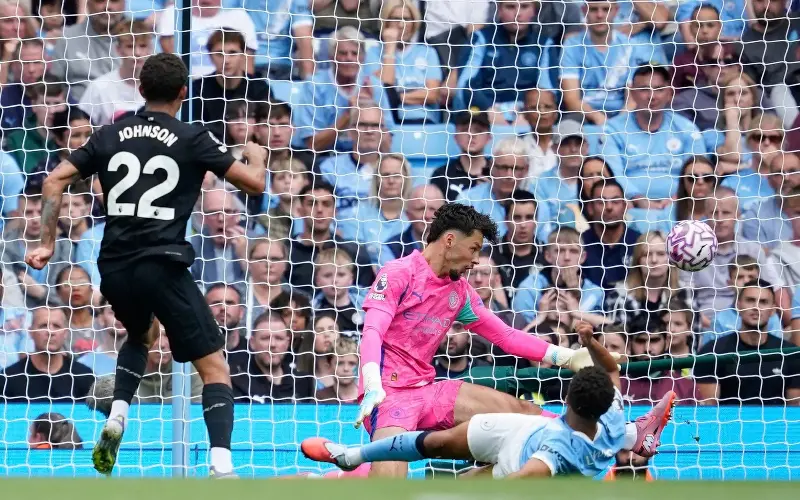
Not since October 2010 have Manchester City fielded a team with a younger average age than the 11 who lined up against Tottenham Hotspur in their second Premier League game of the season. This young side - average age 24 years and 326 days - had a clear plan. The trouble was, this brought clear vulnerabilities, too, as Spurs exploited in their brilliant 2-0 victory.
Manchester City’s big idea
At Manchester United, Sir Alex Ferguson used assistant managers to freshen up the club’s tactics, even while he remained in his post. After his worst season in charge at Man City, Pep Guardiola sought to reinvigorate the side by making a major backroom appointment of his own. Enter Pepijn Lijnders, Jurgen Klopp’s assistant coach for six years at Liverpool.
The ‘other Pep’ is renowned for his commitment to high-pressing, intense football, encouraging defenders to maintain a very aggressive high line, thereby winning offsides just inside their own half.
“One of our main principles is counter pressing,” Lijnders explained in an interview in 2023. “We want to play with a lot of offensive aggression. You use that moment to attack again, because many times the opposition in this moment is not well organised. You want to play in the opposition half and stay there as long as possible.” In training, Lijnders is renowned for a series of games which emphasise winning the ball swiftly back, and denying the side with the ball space.
Since his appointment by Man City, the club have embraced Lijnders’s principles. An especially high line, suffocating opponents and drawing them offside, was a feature of Man City’s 4-0 win at Wolves last week. Jamie Carragher observed Lijnders’s influence on Sky Sports, saying “It made me think, how much influence is the new coach having on this team?”
Tottenham Hotspur’s approach
Man City’s refined approach this season created potential areas for Thomas Frank to exploit. For all Tottenham’s frustrations about failing to sign Eberechi Eze, Spurs still fielded a fine front three: Richarlison, Mohammed Kudus and Brennan Johnson.
Crucially, the trio all possess supreme pace, enabling them to run in behind City’s defence. To use them in this way - and prevent their forwards from stumbling offside, as Wolves repeatedly did last week - Tottenham used a series of high balls over the top. Spurs played 18 per cent of long passes at the Etihad, compared to just eight per cent against Burnley last week.
The tactic became particularly effective after a dollop of luck for Spurs. Rayan Ait-Nouri’s early injury, which led to him being substituted in the 23rd minute, deprived City of his energy at left-back. Nathan Ake, who has often deputised at left-back but is more comfortable at centre-back, looked more exposed, with Kudus constantly harrying him.
Speaking post-match, Frank said: “Yeah we talk about their high line. It is never that easy to train. The goal looks very successful but there were a few times when we didn’t do it well enough. We were offside six times before the goal came so it is not easy. But, yes, of course that is something we had looked at.”
The decisive moments
Within two minutes of Ake coming on, Kudus had already found space against him on the right wing: a harbinger of what was to come.
Spurs continued to attack through their right flank. In the 35th minute, Pape Matar Sarr flicked the ball onto Richarlison, drifting out wide from his notional position as number nine. Tearing down the right flank, Richarlison picked out Johnson, who tucked the ball in from just outside the six-yard box. The offside flag seemed to give City’s defence a reprieve, but only fleetingly. VAR confirmed that Richarlison was not initially offside, with John Stones playing him onside. Crucially, Stones had tried to step out but he got his timing wrong and then slipped as the high line became a problem on this occasion.
Now, City had mislaid their normal sense of calm at home; instead, the jitters that defined their dreadful autumn last year returned. Rather than protect their lead until half-time, Spurs sought to extend it. Another long ball down the right found Kudus. James Trafford came out to close him down and - just about, in the referee’s eyes - got the ball without committing the foul.
Little matter. In injury time, Trafford’s ill-judged attempt to play the ball out from the back from a goal kick allowed Joao Palhinha to convert the chaos into a 2-0 lead for Tottenham. In the second half, Spurs scarcely threatened to relinquish this advantage. This victory was less a heist than a cruise.
The dangers for City
For all the acclaim in which he is held by many of the game’s leading thinkers, Lijnders has not succeeded as manager himself. His two spells as number one have both ended within months; at Red Bull Salzburg last year, Lijnders lasted just 29 games.
These struggles illustrate the intricacies of his system, and the onerous demands that it places on players. At Liverpool, Lijnders’s system also benefited from Virgil Van Dijk’s combination of extraordinary fitness and footballing acumen.
“Pep is unique,” Klopp has said of Lijnders. “I’ve never met anyone like him before and I’m not sure I’ll be fortunate enough to do so again in the future. He is studious and coaching-obsessed; he believes in the training process with a passion I’ve never seen before.”
The snag with such a complicated system, and trying to inculcate it in players with the smoothness that Lijnders did at Liverpool, is that it will require time. The season has scarcely begun. Yet Man City might not feel that they have the time to risk an encore of last season’s disappointments.
